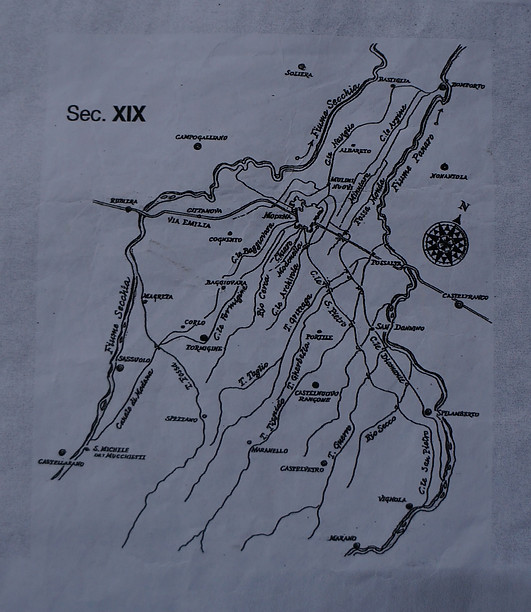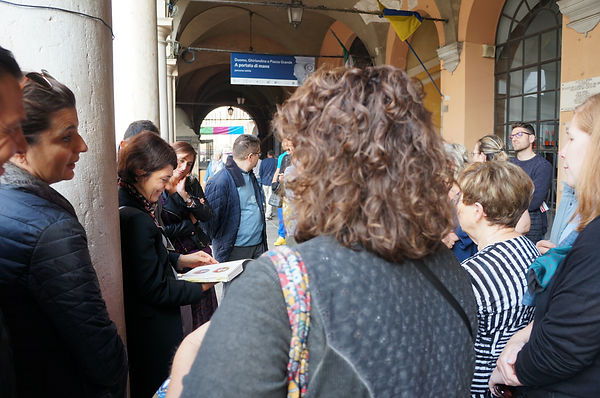section 2:
Tour fORMATS AND PARTICIPANT ENGAGEMENT
Tour formats
The role tour guides play in conveying and perpetuating memories linked to the centro storico can be better understood through a cross-examination of the format, materials and methods used in tours to present stories and memories. The different eras which tours emphasised from water canals of the pre-1600s to the war and resistance of the 1940s, along with different guiding styles resulted in various presentation methods and tour designs. For some tours where the material aspects are hidden or lost, guides relied heavily on materials including maps to promote understanding and connection to stories being told.
During the Percorsi d’acqua tour introduction, the guide E likened Modena to a ‘piccola Venezia’[1], and said that we would ‘need imagination’, as the canals are now closed. A colour-coded map of the canals with a legend and a regional map was handed to us at the start of the tour to aid our understanding of the location and layout of the waterways. I found myself occasionally using the map to guide my understanding, as the music from the nearby Chiesa San Pietro emanated out, and participants’ dogs became restless, drowning out E’s speech. Despite no physical sign of the canals, the map allowed us to follow the layout of the streets, often echoing that of the canals. Many times the names of the roads were attributed to the canals beneath like Corso Canalchiaro or Corso Canalgrande.
Bibliography


City and regional maps provided by the guide.

Different materials were used by each guide, tailored appropriately to each topic. Maps used in the waterways tour allowed the guide to discuss now invisible canals, and enabled participants to make sense of the canal and city layout. For the Este period tour, guide Loredana utilised Rimondi’s (1999) book Estensi to show pictures of key Este period figures. During the Tra Guerra e Resistenza tour, Francesca used a folder of photos, often depicting the aftermath of bombings, for many places along the tour. For example, she showed photos of Via San Paolo of the ‘epoca’[2] to convey the aftermath of heavy bombing on the 13th of February 1944, during which 380 people were killed.
These materials enable tour participants to associate stories and meaning with the current physicality of place, despite many material elements that are no longer existing or visible. As the tours demonstrate, the materials helped participants understand how the underlying canals and the aftermath of ‘bombardamenti’[3] shape certain physical aspects of the existing centro storico. Furthermore, Bajc (2006) argues that attaching images such as those of bomb-sites to certain objects, tour guides change the experience of imagining to reliving a construction of the memory for participants. Tour guides evidently play a pivotal role in the attribution and construction of place meaning within these tours, using these materials to share stories of no-longer physically present materialities of the centro storico. Thus, exemplifying Cresswell’s (2014) argument that meaning is integral to the endurance of place long after the material landscape has changed. In engaging emotionally and promoting understanding of past occurrences through such materials, tour guides can spark stronger, more emotive place attachments for participants.

Francesca uses photos to show the bombardment of Via San Paolo
Loredana recommending that
participants read Rimondi’s (1999) book Estensi


Tour guides also used various storytelling methods to promote understanding or empathy from audiences. In an interview, Loredana discussed her role as a tour guide in sharing histories and memories of the centro storico. She believes her role as a guide is to “avvicina la città a te, quindi la traduce in parole semplici, te la faccia apprezzare nel modo in cui tu riesci a capirla e percepirla.”[4] During her Famiglia d’Este tour, she does this by likening contemporary gossip about ‘William e Kate’[5] to tales of the Este family during her introduction: “facendo capire alle persone che stiamo parlando proprio di cose leggere.” [6] In sharing gossip, she says audiences can more easily engage with trivial content, instead of politics or ‘la storia…con la S maiuscola.’[7] Accordingly, she says she aims to convey how much history has passed within Modena. Loredana selectively presents memories of the centro storico in an accessible manner, allowing residents to learn about Modena’s history while connecting it to the present day, despite the vast contextual differences.
Sharing of participants’ stories
In diverging from the traditional one-way format, Free Walking Tour Italia’s Modenese tours allows residents to act as tourists. This enables tours to become a space to share experiences and personal memories. This is an aspect of Modenese tours Loredana enjoys most, when residents “molto spesso, raccontano a te delle storie personali.”[8] These stories allow for “fotografie del passato che non tutti riescono a conoscere”[9]. Previous tour participants included an older lady who could remember when some of the canals were open and another woman who had grown up in one of the wings of the Palazzo Ducale[10] where her father worked. During the Este tour, we also experienced this sharing of memories:
As we were about to move on from outside a historic convent next to the Military Academy, an older local man rode over on his bike and stopped the group. He began to speak of his own experiences in the convent. Everyone crowded around him in a circle and listened intently, apart from the restless dogs. After the guide Loredana and the rest of the tour thanked him, he went on his way, with a helping push of his bike from some of the tour participants and a lot of quiet, intrigued discussion amongst the group. Unable to understand some of his descriptions, I asked another lady on the tour what he was explaining: she clarified that he had grown up and attended school there when it was a home for orphans.

The local Modenese man points to the convent he grew up in. Participants listen intently.
Evidently, through the reciprocal nature of these tours, participants learn and share personal and collective accounts of place. This exchange of stories and memories is a dynamic social practice which underpins place attachment and also binds people together, promoting a sense of belonging (Casey 1996; Degnen 2016). In sharing these personal and collective meanings of place between group members, these tours facilitate the creation of personal connections to the historical memories of the centro storico, thus strengthening a sense of place for participants.

Foot Notes:
[1] Small Venice
[2] Period
[3] Bombings
[4] Bring the city closer to you, then translate it into simple words, let you appreciate it, in a way that you can understand and perceive it.
[5] William and Kate, the English royal family.
[6] Making people understand that we are talking about light things
[7] History (storia) with a capital ‘S’
[8] Very often tell to you their personal stories
[9] Snapshots of the past that not everyone is about to know
[10] The Ducal Palace of the Este period, currently the Military Academy building.


